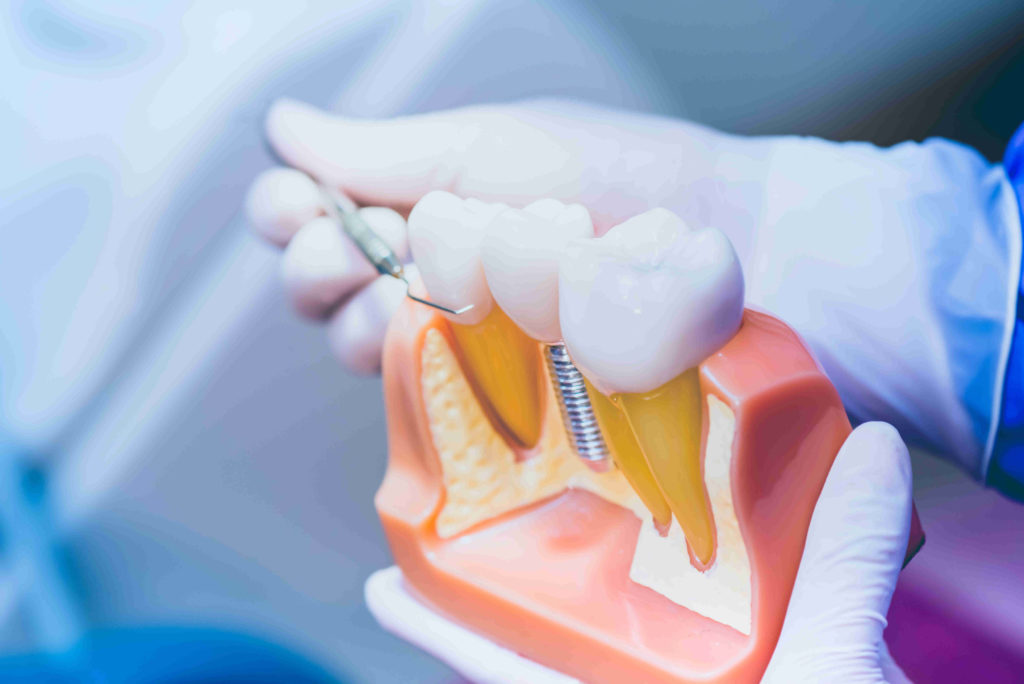The dental implant procedure involves implanting an artificial root into the jawbone, enabling a dental prosthesis to be permanently attached. This solution can be used to replace a missing tooth. Implants can last for decades. How are dental implants placed? What is the procedure like? Are there any contraindications? The Helvident team will help you to better understand dental implantology.
Preliminary examinations for dental implant placement
Before beginning the dental implant placement process, the dental surgeon begins with a thorough evaluation of the patient's oral condition. The practitioner will perform radiographic examinations, such as a panoramic radiograph or CT scan. These examinations are used to assess the available bone volume and surrounding anatomical structures. They also detect any possible contraindications. Once the treatment plan has been established, the dental surgeon can schedule the surgical procedure.
Good to know: implants can be placed from around the age of 18, when growth is complete. This can be verified by a simple radiological examination.
The surgical procedure
Dental implant placement is a surgical procedure performed by dentists. HELVIDENT dental clinics have dentists specialized in dental implantology.
In most cases, the patient is given a local anaesthetic to ensure comfort throughout the procedure. In more complex cases, sedation or even general anesthesia may be required. In the majority of cases, however, the surgical procedure is straightforward and painless.
The procedure begins with an incision in the gum, providing access to the jawbone. Once access has been gained, the dental surgeon prepares a site in the bone where the dental implant will be inserted. The implant, usually made of titanium, is then screwed into the bone. Titanium is a biocompatible material that promotes solid, stable bone integration.
After implant placement
After implant placement, a healing period is necessary to allow optimal bone integration. This period may vary according to the clinical case, but generally lasts between 2 and 6 months. During this period, the implant fuses with the jawbone, forming a stable base for the future denture.
Once healing is complete, a temporary prosthesis can be fitted to ensure proper aesthetics and masticatory function while the gums heal.
Once the gingival tissues have healed, an impression is taken to fabricate a definitive prosthesis. The denturesThe implant, which may be a bridge, crown or removable prosthesis, is then attached to the dental implant using special attachments. This stage is called implant loading. The aim is to restore chewing function and esthetics by permanently replacing the missing tooth. Implants are the solution of choice, as they can replace one or more teeth without affecting other teeth, and offer a prosthesis that is both fixed and comfortable.
Do you have one or more dental implants? We recommend that you observe extremely rigorous dental hygiene and have regular check-ups with your dentist.
Contraindications to dental implant surgery
Dental implants in Switzerland have a high success rate. It generally exceeds 95 %.
However, there are certain contraindications and prerequisites to be taken into account before a dental implant is placed. These include
- sufficient volume and quality of the jawbone,
- good oral hygiene,
- healthy neighboring teeth and gums,
- the absence of serious oral pathologies,
- unbalanced diabetes,
- the smoking.
The dental surgeon will assess these aspects during preliminary examinations. It is sometimes possible to increase bone volume with a pre-implant bone graft.
There are also two rare absolute contraindications:
- irradiation of the face,
- high risk of infective endocarditis (infection of a heart valve by bacteria from the mouth).
Please note: it's important to tell your practitioner about any illnesses you have (even those you don't think are important), and to specify any medication you are taking on a regular basis.
In brief
Placing a dental implant is a complex surgical procedure, but one that is well mastered by dentists specializing in dental implantology. This procedure enables the permanent and effective replacement of a missing tooth. The aim is to improve masticatory function, aesthetics and the patient's overall quality of life. It is essential to consult a competent professional for a personalized treatment plan tailored to each specific case.
HELVIDENT dental centers and clinics welcome you in Lausanne, Fribourg and Aigle. Don't hesitate to Contact us to make an appointment or request more information about our services.

